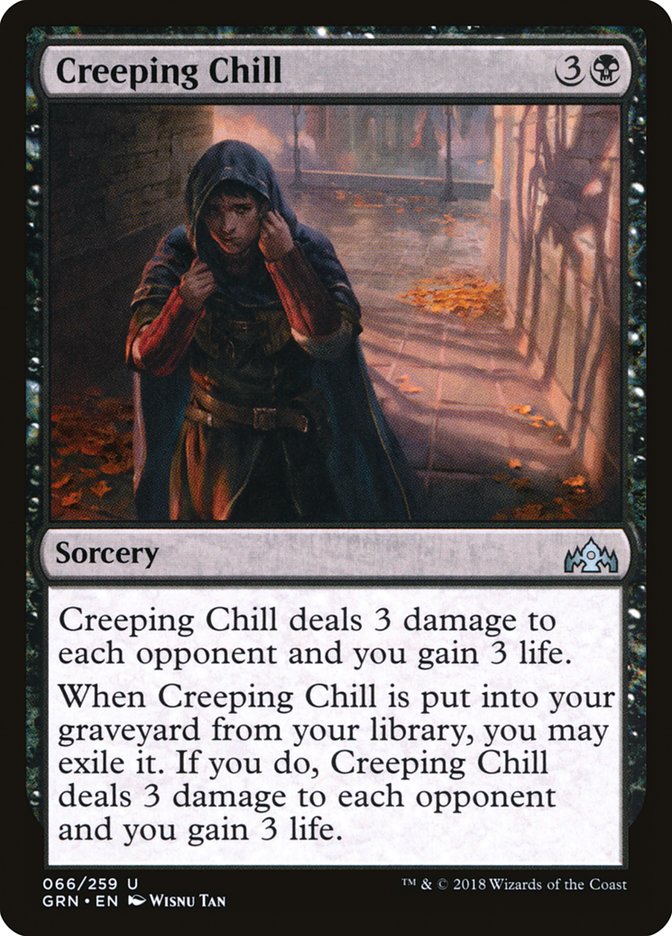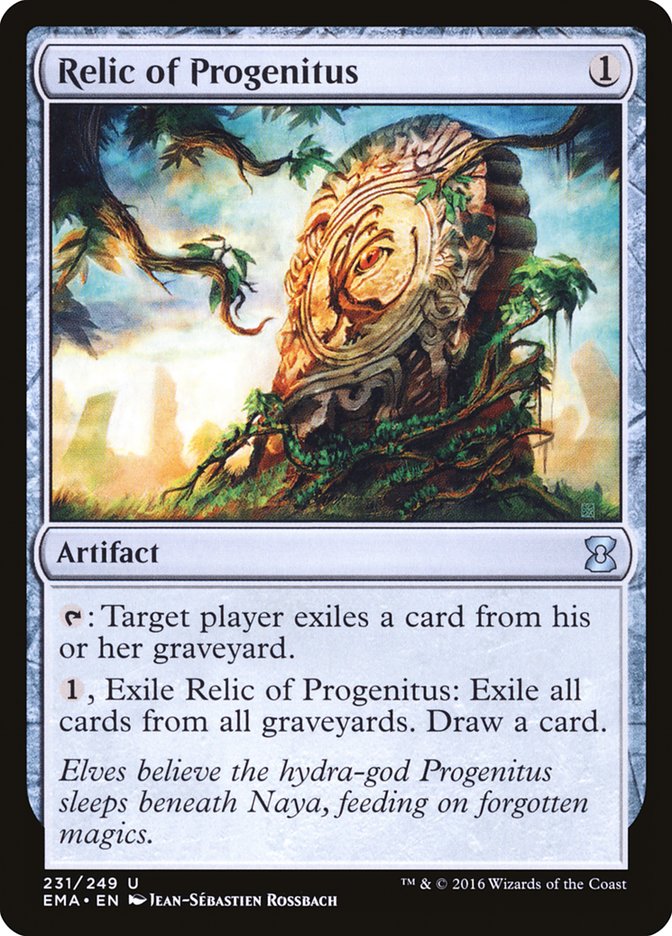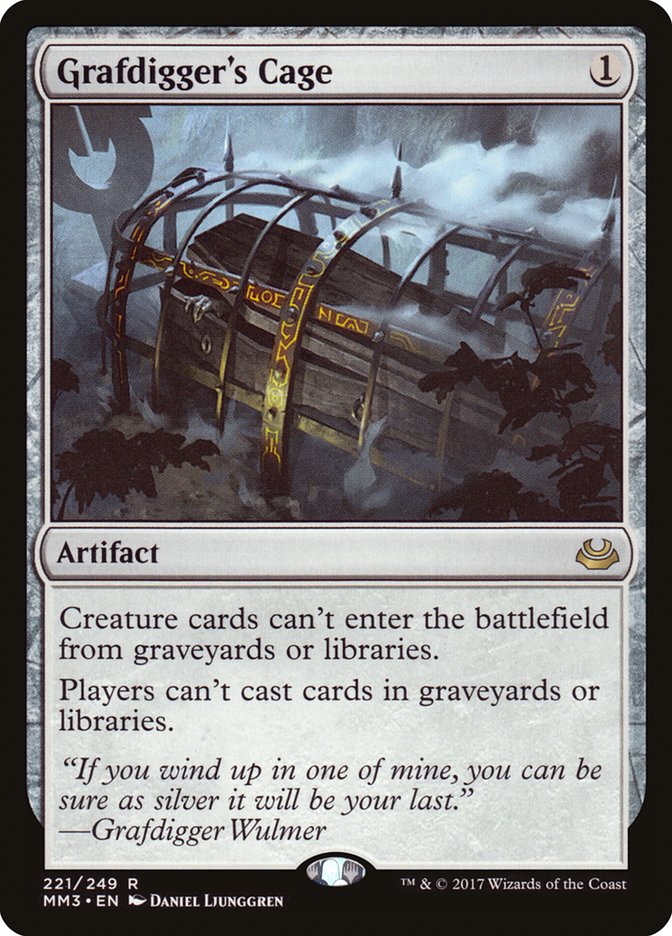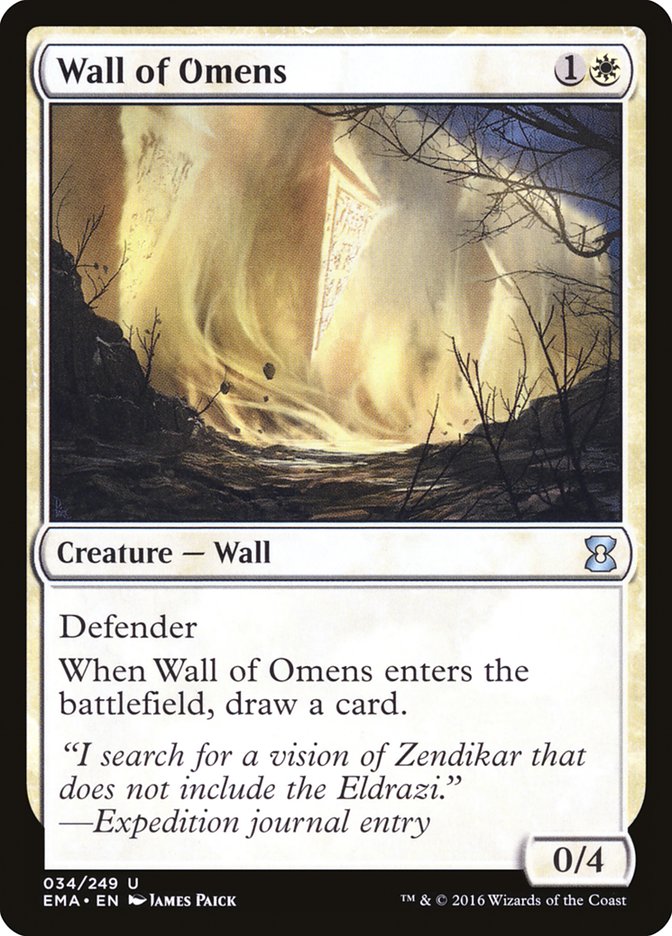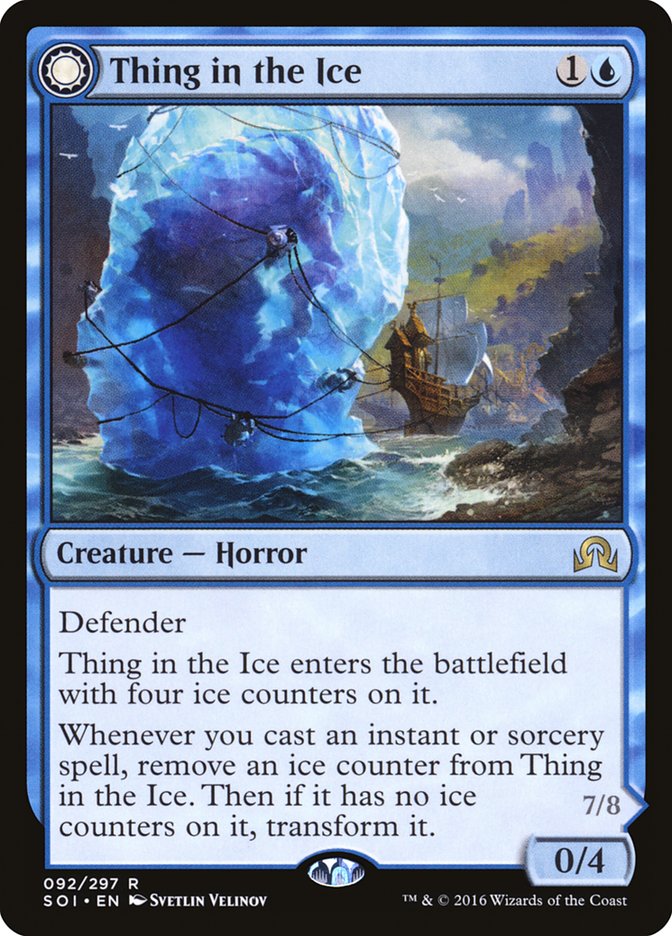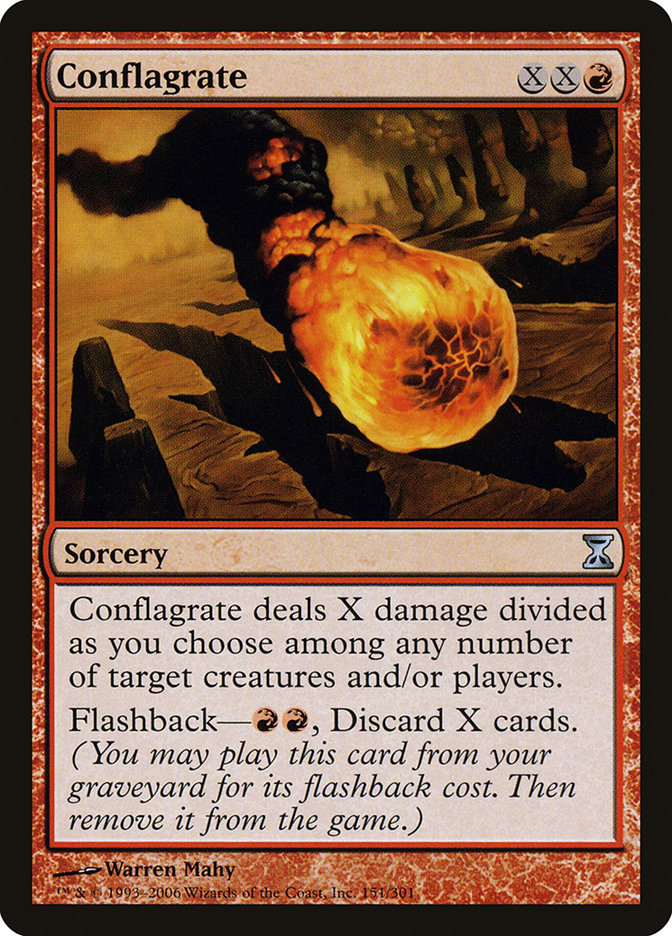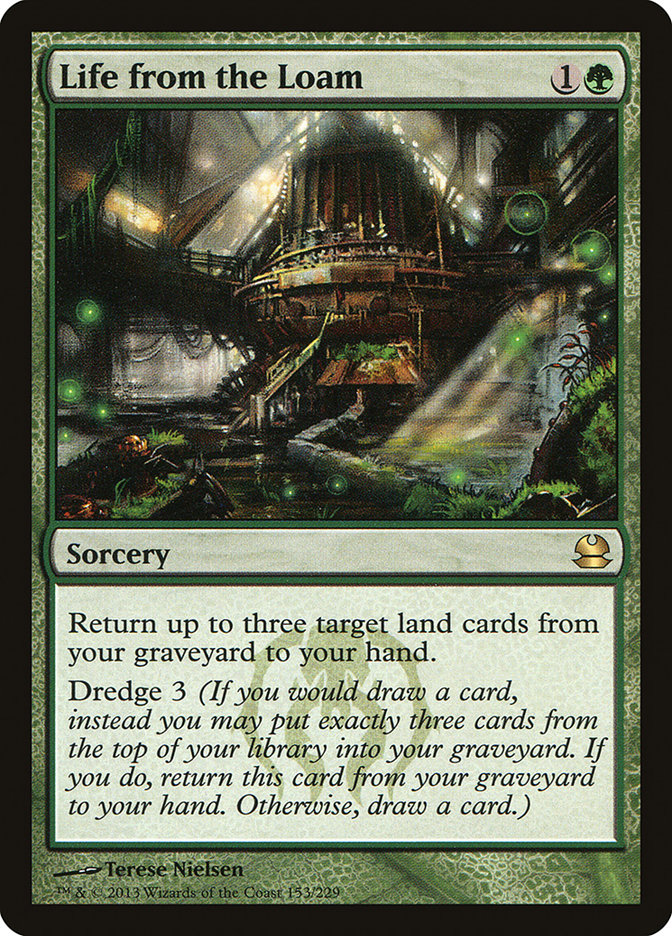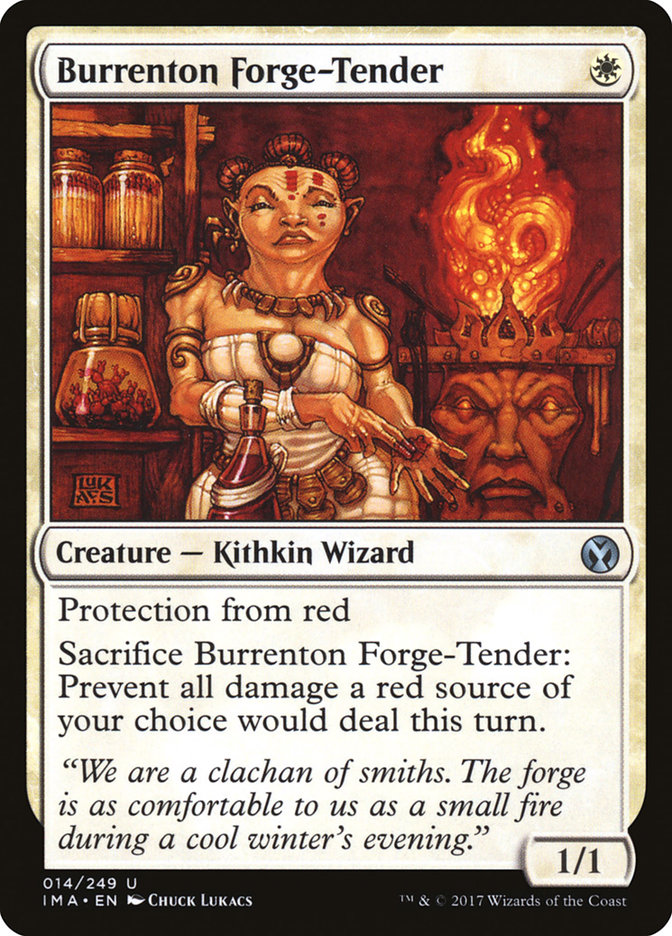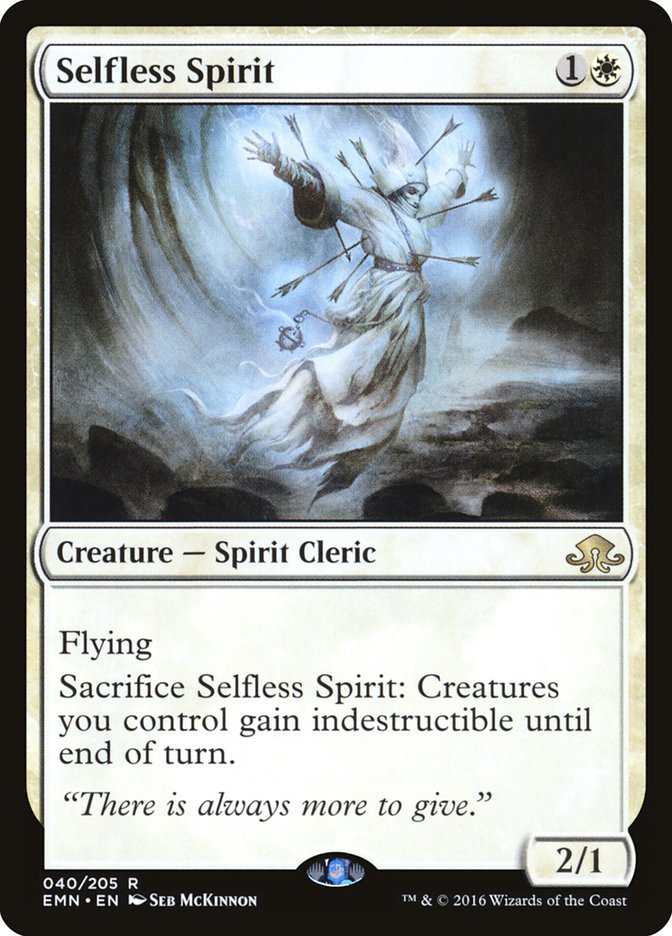It’s official. Dredge is back in Modern.
After weeks of performing well on Magic Online, the deck more than backed up its digital results during the first major test in paper, taking the most slots in Day 2 of the Open last weekend in Dallas, an impressive fifteen percent of the field. With two of those players making the Top 4 and a mere life point away from the trophy, Dredge was the talk of the tournament, and it’s clearly here to stay.
That means it’s up to you to learn how to beat the deck. Creeping Chill has not fundamentally altered the deck, merely allowed it to recoup some of the explosiveness it lost when Golgari Grave-Troll was rebanned. Being that Dredge is the Modern deck that I have the most experience with, here’s my advice for how to prepare for the upcoming sea of Stinkweed Imps and Conflagrates.
The Inadequacy of Hate
Many players are going to react in a very predictable way: adding a few more copies of their preferred graveyard hate card and calling it a day. Dredge has a reputation as a deck that’s miserable to play against, which causes many players to skimp on testing against it and rely on their hate cards to do the heavy lifting against a linear deck.
This is a poor approach to the matchup for several reasons. On a fundamental level, if you’re relying on hate cards to win any matchup, you’re essentially conceding Game 1. That means you’ll have to draw your hate cards in both sideboard games to consistently win the matchup, and that’s against an opponent who’s prepared for your hate. If the opponent has an answer or you fail to find a hate card, you’re a huge underdog.
And against Dredge, you need to find that hate card quickly. A Turn 4 Rest in Peace or Relic of Progenitus is likely not going to be good enough even if they don’t have an answer, because by then the damage is likely already done. In a format as diverse as Modern you simply can’t devote the necessary sideboard space to hate cards for a single deck in order to turn those cards into a plan in and of themselves.
That said, graveyard hate does have a critical role to play in combating Dredge, but it’s one tool to be used in concert with other forms of disruption, not a universally effective sledgehammer for the matchup. I analyzed the different kinds of graveyard hate when Dredge first emerged in Modern, and much of what I wrote then stands true today, but there are some things to update now that Golgari Grave-Troll is out of the format.
First is that Rest in Peace is more effective, because the deck still doesn’t get on the battlefield as quickly as it used to. The recouped explosiveness is due to additional reach, but that reach is irrelevant if they have no battlefield presence to back it up. Like Leyline of the Void, Dredge essentially can’t operate while Rest in Peace is on the battlefield, so it’s best supplemented by cards that protect it from opposing removal, like Thoughtseize out of Leyline decks and Spell Queller or counterspells out of decks with Rest in Peace.
You don’t want to go out of your way to add protection cards to your deck because counterspells and discard are only effective in small doses against Dredge (typically to strip an early enabler or counter a key Conflagrate), but having a few will give you a powerful “protect the queen” strategy that you can execute. I particularly like Spell Queller since it can answer Life from the Loam, thereby neutering the power of Conflagrate, and it pressures them in the air while you focus on handling their ground creatures.
Grafdigger’s Cage also gets better, since one of the better options to beat it, casting large Golgari Grave-Trolls, is no longer available. It still runs into the issue of letting them fill their graveyard, so once it is answered they will build a battlefield immediately, but it also stops their most explosive draws, so expect to see more of these around.
And lastly, if you’re thinking of using the one-shot effects like Tormod’s Crypt, Relic of Progenitus, or Ravenous Trap, know that they are only speed bumps and need to be backed up by pressure. By themselves they will only delay the inevitable and need to be augmented by some way to close the game while they stumble or win the long game. Tron does this effectively with powerful effects like Wurmcoil Engine and Ugin, the Spirit Dragon, while a combo deck like Ironworks can use Tormod’s Crypt as a way to buy an extra turn in the race that still has functionality in their own combo as an artifact to sacrifice for mana.
Humans is another deck that uses these effects to win a race, which is why I’m a big fan of Zan Syed’s copies of Tormod’s Crypt. He came into the tournament respecting Dredge and was rewarded with a Top 8 finish. In the turn or two that Dredge will need to recover from a Tormod’s Crypt, Humans can either end the game or amass a battlefield that even Conflagrate won’t be enough to stabilize.
Creatures (37)
- 4 Meddling Mage
- 4 Noble Hierarch
- 4 Phantasmal Image
- 4 Champion of the Parish
- 3 Thalia, Guardian of Thraben
- 4 Mantis Rider
- 4 Reflector Mage
- 4 Thalia's Lieutenant
- 4 Kitesail Freebooter
- 2 Militia Bugler
Lands (19)
Spells (4)

Picking the right hate card for your strategy will be important, but more important is to understand how Dredge works so you can devise the right strategy for the matchup in the first place.
The Fundamentals of Dredge
One of the many edges that Dredge players maintain is their opponents’ lack of familiarity with how the deck operates. It’s common knowledge that Dredge plays a much different game of Magic from any other deck in the game’s history, but that’s only partially true. The deck plays out of its graveyard and uses the dredge mechanic to effectively draw more than one card per turn, so on the surface it looks distinct from a more typical strategy, but Dredge still utilizes fundamental principles of Magic, and the best way to consistently beat the deck is to understand the deck on that fundamental level.
Modern Dredge, in reality, is an aggro deck. Many players view it as a combo deck because that’s what other incarnations of the deck, namely those with Dread Return and Bridge from Below, are, but the Modern version is actually quite fair. It amasses a battlefield of creatures on the first two to four turns of the game and backs them up with removal and reach provided by Conflagrate and Creeping Chill. It doesn’t cast its creatures like a normal aggro deck, but that’s not relevant outside of the obvious weakness to graveyard hate.
What sets Dredge apart from typical aggressive decks is that cheap spot removal and most sweepers are almost completely ineffective. Tagging a Narcomoeba is okay, but over time, Bloodghast and Prized Amalgam will outlast any amount of spot removal so long as they’re careful not to dredge through their deck too quickly. Path to Exile and Anger of the Gods are about the only commonly played removal spells that are effective against both Dredge and Humans.
That’s why Dredge’s best matchups are historically slow, removal-heavy decks like Jund and Jeskai. But that’s not the only way to play defense against an aggressive deck. The best way to play defense against recursive creatures is in the combat step itself.
During last weekend’s Open, Patrick Sullivan made an astute observation that Tarmogoyf, which has seen its stock in Modern plummet over the last two years, is a very effective tool against Dredge because of its prowess in combat-oriented matchups, and I agree. If your Dredge opponent stumbles, you can start pressuring them and use your otherwise poor spot removal to keep the pressure on, and if they don’t, you at least have a way to buy time and find some other way into the game.
Dredge’s responses to this kind of defensive strategy are to either go wide or break through with a big Conflagrate or some other removal from the sideboard like Lightning Axe and Assassin’s Trophy. Against their best draws you’re unlikely to stop them from going wide, but in general, the best way to get around this is with fliers. Mantis Rider is among the best cards for Humans against Dredge because it applies pressure while also playing defense, though pumping some Kitesail Freebooters can also do the trick. Peter Hollman utilized Temur Battle Rage and Ghor-Clan Rampager to give another form of evasion to his large creatures, which were critical on his road to the trophy.
It’s virtually impossible for Dredge to play offense and defense at the same time, so one or two viable attackers will be enough to allow you to focus your energies on clogging the ground and put the Dredge player on the defensive, at which point their recursion is only a stall tactic, not a way to gain traction in the game. The one thing to be careful of is to not trade resources too aggressively via your attacks, since then they can outlast you in material.
Note that even in slower, less creature-heavy decks, you can still incorporate some defensive cards that are good against Dredge. For example, Wall of Omens is a solid option for Azorius Control, and Thing in the Ice is particularly effective if you’re spell-heavy, since it plays early defense and then lets you turn the corner immediately once transformed.
As for Conflagrate, that’s a trickier piece of the puzzle. Often, graveyard hate will be pointed wisely at the card in decks that can otherwise win on the battlefield, but you shouldn’t rely on your sideboard cards. The two most successful creature decks, Humans and Bant Spirits, both have built-in answers to Conflagrate, the former from Meddling Mage and the latter from hexproof-granting creatures, but both those plans weaken in the face of Dredge’s sideboard removal.
The fundamental flaw is their focus on Conflagrate itself. The better target is Life from the Loam. Without Loam, Conflagrate loses much of its power, and you get the side benefit of making it more difficult to recur Bloodghast. Not all decks have a way to disrupt Life from the Loam, but those that do have one of the most underrated means of disrupting Dredge. The most common way of disrupting Life from the Loam is to cut off their access to green mana. Dredge operates on a low land count early in the game, so a well-timed Field of Ruin or Ghost Quarter can shut off a key element of their plan.
Now, if they resolve a Loam early in the game they will likely have a green source in reserve, so this is not a consistently available tactic, but it’s one you need to be aware of if you’re playing Golgari Midrange, Azorius Control, or Selesnya Company because it can absolutely cripple a Dredge player caught unaware.
Blood Moon can act in a similar fashion, but even more powerfully, since it will completely cut off their access to green mana. You wouldn’t think Blood Moon could be good against a deck that is mostly red and doesn’t cast many spells, but it’s quite effective, especially for any deck that needs to play a longer game. If you’ve been sideboarding them out, you’re making a serious mistake.
Some lists of Dredge play a basic Forest to guard against these mana denial tactics, but with the deck on a scant nineteen lands, I don’t think you have room. I’ve considered sideboarding a copy, but with four Leyline of the Void being mandatory for the mirror, there’s no room there either. I don’t see a Forest being commonplace in Dredge, so if you’re playing a deck with an easy way to disrupt their mana and stop Life from the Loam, learn how to utilize it.
The key to all of these tactics is that they allow you to win games against Dredge without relying on graveyard hate. Adding more graveyard hate to your sideboard will have diminishing returns in your Dredge matchup while sacrificing valuable percentage points against much of the rest of the metagame. The best way to improve your Dredge matchup is bolstering your strategy for Game 1.
Ignoring Them
Of course, the best way to win Game 1 against Dredge is to have a strategy that goes over the top of what they’re doing. That means playing big mana and combo decks that can effectively race Dredge or trump them on the battlefield by Turn 44. Dredge’s engine takes up a lot of slots, so even with a solid sideboard, they don’t have much room to shift their strategy to handle decks like this. These are matchups where Creeping Chill was incredibly important, because previously Dredge had little chance of racing. Now they’re about on even speed, so it’s not a slam dunk, but still a good place to be.
Leyline of the Void is already in their sideboard for the mirror, so I’d avoid combo decks that rely on the graveyard like Storm or Ironworks, though both are resilient enough to still compete. Last weekend we saw Tron perform quite well, which is one of the best examples of a deck that goes over the top of Dredge with cards like Ugin, the Spirit Dragon and Wurmcoil Engine. It also gets to play maindeck Relic of Progenitus, so I expect to see Tron back among the top decks.
Infect was also more successful than it has been recently and another strong choice for those looking to attack Dredge from this angle. Infect was one of Dredge’s main foils when it had Golgari Grave-Troll because it’s a turn faster and has built-in ways to dodge Dredge’s interaction. Infect is also the primary beneficiary of Dredge pushing heavy-removal decks down, so if you’ve been waiting to unleash your inner Tom Ross, now’s the time.
Outside of those two, I think there are three less common Modern decks that get better in a Dredge-centric metagame:
Amulet Titan
Creatures (15)
- 4 Azusa, Lost but Seeking
- 4 Sakura-Tribe Scout
- 4 Primeval Titan
- 1 Reclamation Sage
- 1 Walking Ballista
- 1 Zacama, Primal Calamity
Lands (28)
Spells (17)

Another big mana deck, this one was recommended by Ari Lax in last week’s What We’d Play column, and I echo his endorsement. The ability to find a Bojuka Bog by Turn 3, either via Primeval Titan or Tolaria West, and then recur it via bounce lands means that Dredge is under a lot of pressure to get on the battlefield early, and between Zacama, Primal Calamity and Hornet Queen, Amulet Titan has the ability to stabilize the battlefield.
There’s also the potential to simply race with an explosive draw, and that’s all without considering the sideboard. Amulet Titan may suffer against Infect, but it’s solid against decks that play to the battlefield and Tron.
Ad Nauseam
Creatures (5)
Lands (20)
Spells (35)

Dredge has essentially no disruption for Ad Nauseam outside of a couple of discard spells in the sideboard and destroying Phyrexian Unlife. Game 1 is a pure race and Unlife buys the Ad Nauseam player a ton of time, especially when combined with Angel’s Grace acting as a Gog.
This is another deck that benefits if heavy discard decks are pushed down by Dredge, which can also free sideboard space for anti-Dredge cards. Infect is still a huge problem, though.
Selesnya Elves
Creatures (34)
- 4 Llanowar Elves
- 2 Boreal Druid
- 4 Heritage Druid
- 4 Devoted Druid
- 2 Nettle Sentinel
- 4 Elvish Archdruid
- 4 Ezuri, Renegade Leader
- 4 Elvish Mystic
- 4 Dwynen's Elite
- 2 Vizier of Remedies
Lands (18)
Spells (8)

In general I like the Devoted Druid / Vizier of Remedies combo against Dredge, since their primary form of creature interaction, Conflagrate, is sorcery-speed, and I think Selesnya Elves is the best deck with that combo. There are certainly games where Conflagrate is a problem, but Ezuri, Renegade Leader can protect you from it, or you can force it to act as a one-for-one with a Turn 2 Devoted Druid. If it proves to be more problematic, a sideboard copy of Burrenton Forge-Tender or Selfless Spirit could also help out.
Saving Conflagrate, Elves is going to have a difficult time keeping up with Elves, and eventually you will amass a battlefield that they can’t attack into, or you can simply execute the combo as early as Turn 3, completely ignoring any creatures they recur. The pressure to find a Conflagrate quickly is real, since they typically are casting enablers on the first two turns of the game, and having to take Turn 2 off to answer a Devoted Druid gives you time to build a battlefield of Elves.
The sideboard has plenty of graveyard hate and you have the clock to take advantage of Rest in Peace, even if gets answered quickly, and the mana production to make Scavenging Ooze a slam dunk. The games you lose to Dredge often look embarrassing, but you win more than your share of the others. After all, Liam Lonaegan defeated Tom Ross 3-0 in the Top 8 of the Invitational he won, and that was with Golgari Grave-Troll still around.
***
There’s no doubt that Dredge is a powerful deck. But as a deck that on the surface plays out differently from any other, it has benefited a lot from players not approaching the matchup correctly and misusing their hate cards. Dredge is still a Magic deck, and you don’t have to shuffle up four copies of Leyline of the Void and cross your fingers in order to win. Take these principles and apply them to your deck of choice and you’ll be able to compete.


